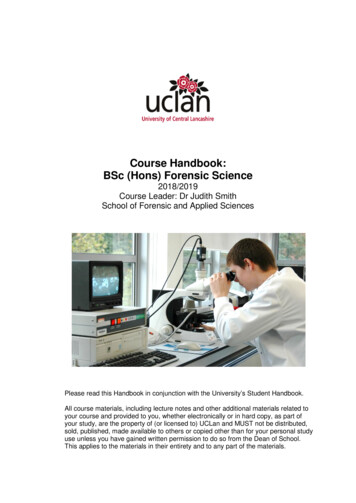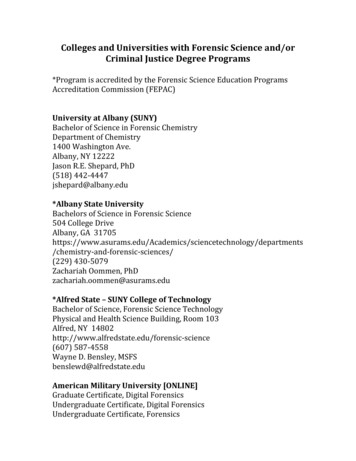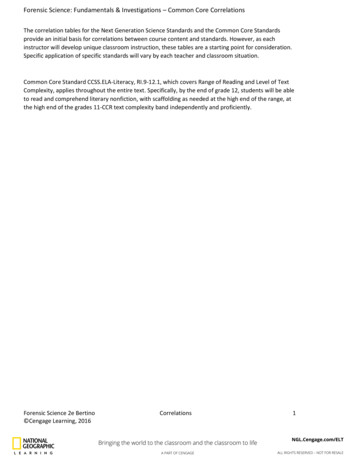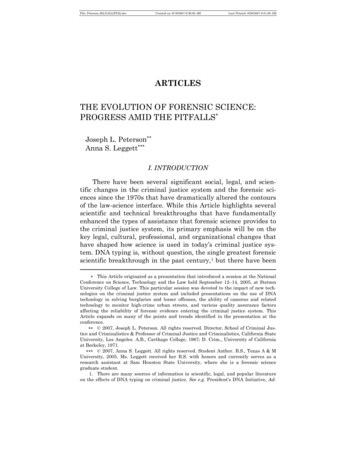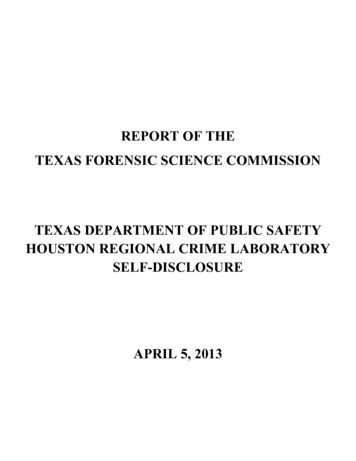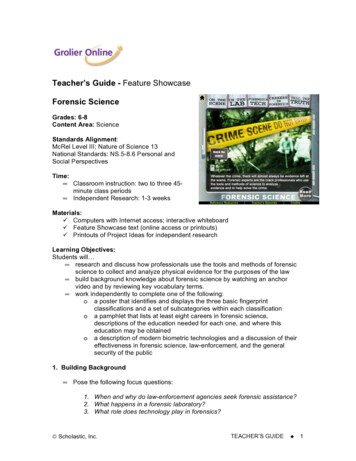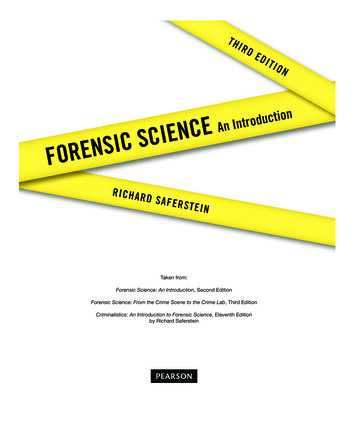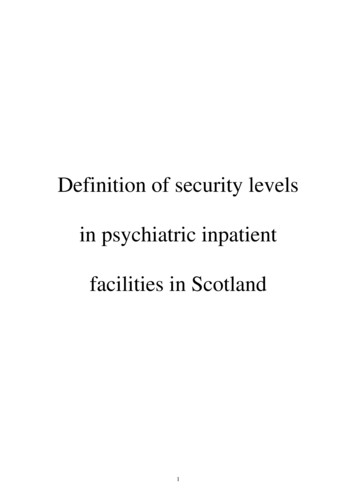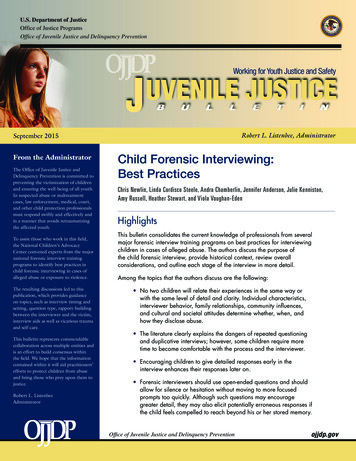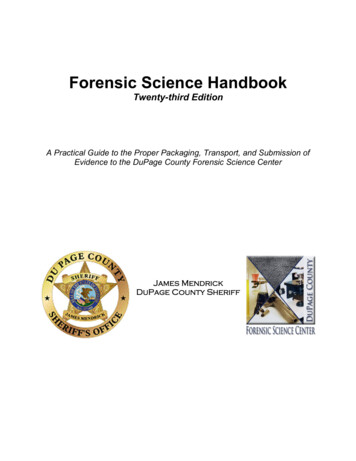
Transcription
Forensic Science HandbookTwenty-third EditionA Practical Guide to the Proper Packaging, Transport, and Submission ofEvidence to the DuPage County Forensic Science CenterJames MendrickDuPage County Sheriff
2Forensic Science CenterDuPage County, IllinoisA Division of the DuPage County Sheriff’s OfficeSheriff James Mendrick(630) 407-2000sheriff@dupagesheriff.orgUndersheriff Edmond Moore(630) 407-2002ed.moore@dupagesheriff.orgDirector Claire Dragovich(630) tegrity*QualityThe DuPage County Forensic Science Center is accredited by the ANSINational Accreditation Board (ANAB) to the ISO/IEC 17025:2017, theANAB 17025:2017 Forensic Science Testing and Calibration LaboratoriesAccreditation Requirements and the FBI Quality Assurance Standards forForensic Testing Laboratories:2011, certificate number: FT-0241.Forensic Science Handbook, 23rd Edition, Released August 27, 2021
3CONTENTSGeneral Information and Instructions4445566679Our MissionWhat all Agencies Must KnowCommunicationDirections & AppointmentsContacting our StaffIt’s Your Forensic Science LaboratoryUnderstanding Testing ReportsFeedback & ComplaintsGeneral Submission ProceduresMajor Case ReviewsScientific Services9111213Controlled SubstancesLatent PrintsFirearms (Ballistics)Forensic Biology & DNASome excerpts of this handbook were quoted or paraphrased from the FBI Handbook of Forensic Services, whichcan be found at rensic-services-pdf.pdf/viewForensic Science Handbook, 23rd Edition, Released August 27, 2021
4Our MissionThe DuPage County Forensic Science Center is a division of the DuPage County Sheriff’s Office. Ourmission is to support the criminal justice system with accurate, efficient, ethical, and professional scientificservices that contribute to a higher quality of life for the citizens of DuPage County. Five main objectivesto achieve the mission are: Maintaining proper facilities for casework and the receipt of evidence.Employing and training highly qualified scientists.Adhering to scientifically accepted procedures and laboratory quality assurance standards.Reporting analytical findings coherently and efficiently.Clearly articulating analytical findings in courts of law.Scientists working within the center have access to state-of-the-art instrumentation, training opportunities,current literature, and a network of professional peers with which to exchange pertinent information.Collectively, these resources enhance the scientific reliability and accuracy of information reported by ourlaboratory.What all Agencies Must KnowThis handbook is an official communication put forth by the DuPage County Sheriff’s Office for the benefitof all users of its forensic science services. Nonconformity to laboratory policies may result in the return ofevidence to the submitting agency without analysis or the inclusion of language in a testing report or experttestimony that describes the nonconformity and its potential effect on evidence examinations.It is critical that all participants in the DuPage County criminal justice system understand that the laboratoryemploys a complex quality-management system that includes carefully documented methods, scientificallyvalidated procedures, and quality-control policies. They are in place to protect the integrity of thelaboratory’s work product and to prevent complications to ongoing investigations and court. Each agencythat works with the laboratory is, in essence, a part of this quality-management system. As such, eachagency should strive to adhere to the guidelines and requirements set forth in this handbook.CommunicationIn addition to communicating with your agency the laboratory communicates with all users of its forensicscience services. Staff discuss analysis requests with members of the State’s Attorney’s Office andparticipate in pre-trial meetings with prosecutors and defense attorneys. The laboratory complies withsubpoenas duces tecum, FOIA requests and Illinois Supreme Court Ruling 417 by providing copies oftesting reports, note packets, submission information (including tendered police reports), communicationsand other laboratory generated documents in accordance with the law.Forensic Science Handbook, 23rd Edition, Released August 27, 2021
5DirectionsThe laboratory is located at the DuPage County GovernmentCenter, situated on the east side of North County Farm Roadapproximately one half-mile north of Roosevelt Road (Route 38)in Wheaton. Located in the James “Pate” Philip Forensic ScienceCenter, the laboratory is on the second floor of the 501 building.Follow signs to the Sheriff's Office / Jail and park at the west endof the 501 building. Upon entry of the first floor vestibule press the‘Crime Lab’ button next to the elevator for access to the secondfloor.AppointmentsTo make an appointment to submit or pick-up evidence, visit the laboratory Bookings website okings/In the event of exigent circumstances requiring a same-day submission, contact either evidence receiving(630.407.2111) or the main laboratory line (630.407.2100) to schedule an appointment. The minimum lead-time for online bookings is 17.5 hours (i.e. the minimum number of hours outfrom an appointment you can book). The maximum lead-time for online bookings is 30 days (i.e. the maximum number of days out youcan book an appointment) Please plan to be at the lab at your selected appointment time. Our staff have multiple duties andplan their work around your appointments. In the event of unforeseen circumstances, please callus so we can plan accordingly. Appointments are set for 30 minutes. If you have a significant amount of evidence please book twoback-to-back appointments. Please give us a call if you have a submission question or need to screen a submission. The DuPage County Forensic Science Center DOES NOT ACCEPT mailed evidence.Contacting our StaffLaboratory Director / Quality Manager(630) 407-2101Evidence Receiving(630) 407-2111Drug Chemistry Technical Leader / ChemistrySupervisor(630) 407-2103Chemistry Section(630) 407-2099DNA & Forensic Biology Technical Leader /Supervisor(630) 407-2151Forensic Biology/DNA Section(630) 407-2104Latent Print Technical Leader(630) 407-2110Criminalistics Section – Latent Prints(630) 407-2112Forensic Science Handbook, 23rd Edition, Released August 27, 2021
6It’s Your Forensic Science LaboratorySince 1969, the citizens of DuPage County have benefited from the services provided by the laboratory,which are available to all law enforcement agencies in the county.To maximize the benefits of these services, each agency within the DuPage County Criminal JusticeSystem must work in partnership with their laboratory in the following ways: Have a full understanding of the laboratory’s capabilities and limitations.Be specific when requesting services. The role of a forensic science laboratory is to answer questions.The more specific the questions are, the more specific our answers will often be.Submit evidence with ample case information such as a copy of an incident report, summary of theincident, or other narrative describing the crime scene, incident, and persons involved.Be familiar with your evidence and the case so that laboratory personnel can ask questions ifnecessary.In the event of a change in case status, for example, adjudication or charges dropped; contact thelaboratory for cancellation of the testing request.The laboratory evaluates all requests for testing to include a determination that the request is areasonable use of resources.In the interest of this on-going partnership, the laboratory offers a number of services to enhanceprofessional awareness of its capabilities: The Introduction to Crime Laboratory Services Seminar for submitting agencies.The Forensic Science Handbook – a practical guide to the proper packaging, transport, and submissionof evidence to the DuPage County Forensic Science Center.A website, www.dupageforensics.org that allows 24-hour-a-day access to information about ourlaboratory.Ultimately, efforts to enhance this partnership will pay dividends, helping to make DuPage County safer forour citizens and the police officers that work day and night to keep them safe.Understanding Testing ReportsThe laboratory reports its results and conclusions in the form of a testing report with a unique identifier. Theunique identifier is the laboratory case number followed by a sequential digit, e.g., 21-0093-03 where: 21 is the year, 2021, in which the case was created.0093 represents the ninety-third case accepted by the lab in 2021.03 represents the third testing report issued for case number 21-0093.The results communicated in a laboratory testing report contain observations, results, and conclusionsrendered by a scientist who has the requisite training to conduct the analyses. Laboratory staff are availableto answer questions regarding reports, are available for pre-trial conferences with both prosecution anddefense and will testify in court when needed.Feedback & ComplaintsThe law enforcement community of DuPage County is encouraged to voice any feedback or complaintswith our forensic science services or personnel as soon as possible. Feedback forms are available atevidence receiving and online 10,%20Customer%20Feedback.pdfAdditionally feedback and complaints can be made to the director by phone (630) 407-2101 or in writingclaire.dragovich@dupagesheriff.org. If it is necessary to bypass the director, direct complaints to SheriffJames Mendrick at (630) 407-2001.Forensic Science Handbook, 23rd Edition, Released August 27, 2021
7General Submission ProceduresThis section provides basic instructions for the submission of evidence to the laboratory. No set ofinstructions, however, can encompass every possible scenario that may arise. Use common sense in thecollection, preservation, and transport of evidence. Be sure to read the section titled “SpecialConsiderations” for each service for more information.1.Place evidence exhibits in appropriate containers. Contact the laboratory when needing tosubmit large and bulky items that do not easily lend themselves to packaging.2.Seal each container with tamper-indicating tape.3.Handwrite your initials and the date across the tape and onto the surface of the package.4.Mark each package with the agency name, case number and a unique identifier if there aremultiple packages for the same case number (e.g. Package 1 of 2, Package 2 of 2).5.Complete an Evidence Submission Form. Agencies must use either this .10%20General%20Submission%20FormsNEW.pdfOr for agencies that utilize the BEAST evidence management software a printed copy of the labsubmission sheet.6.Complete a DNA Evidence Submission Form. This form must accompany all forensicbiology/DNA submissions: NA%20Analysis%20Request.pdf7.Write or include a summary of the incident. The length and detail of the summary should becommensurate with the complexity of the case.8.Transport your evidence and documentation to the lab. You must schedule an appointmentprior to transporting evidence to the laboratory.9.Retrieve evidence from the laboratory. Upon receipt of testing report, retrieve evidence fromlaboratory (appointment needed). The laboratory mails all testing reports, additionally sexualassault DNA reports are emailed. Reports are available electronically to the DuPage County State’sAttorney Office.Describing Your EvidenceWhen listing evidence on the submission form, it is not necessary to give lengthy descriptions or describesecondary containers. For example: “DNA buccal swab from Victim Jane Doe”“White powder (from John Doe)”“Latent lift from exterior rear window”The purpose of an evidence submission form is to inventory what is in the package and (in some cases)from whom or where it was recovered.ABIS (Automated Biometrics Identification System) and NGI (Next Generation Identification)Searches – Latent PrintsIf standards are unavailable but the individual has an Illinois State Identification (SID) number and/or anFBI number, the laboratory may be able to retrieve standards for that individual. In those instances,please provide the Illinois SID number and/or the FBI number so that the laboratory may use thatinformation to attempt to obtain standards for comparison purposes.Forensic Science Handbook, 23rd Edition, Released August 27, 2021
8CODIS (Combined DNA Index System) Searches – DNACODIS is not like ABIS in that no names or other personal identifiers of the offenders, arrestees, ordetainees are stored using the CODIS software. Therefore, the DNA profile from a specific convictedoffender based on name/DOB/SID# cannot be accessed and used for comparison purposes.Sexual Assault EvidenceThe Illinois State Police administers a sexual assault evidence tracking website called CheckPoint. SexualAssault Kits (SAKs) or if no SAK was collected the first piece of other evidence collected, are assigned atracking ‘K#’ by either the hospital (SAK) or the investigating agency (other evidence if not SAK).When evidence is submitted related to a sexual assault investigation provide the laboratory with the K# andan email address for the emailing of DNA testing reports.Laboratory Evidence RoutingForensic science laboratories process evidence in a specific order. The following is the routing policy ofthe laboratory:The sequence in which the laboratory processes evidence can have a significant impacton the integrity of the evidence. The following is the recommended sequence unless casespecifics dictate otherwise:1.Forensic Biology2.Latent Fingerprints3.Controlled SubstancesAnalysts will assess how and if a specific analysis may compromise the suitability of theevidence for analysis by subsequent disciplines. When such circumstances are present,the analysts from the corresponding sections of interest will confer and act accordingly.Selecting Your PackagesThe packages or containers selected for evidence will often depend on the evidence itself. Evidencepackages fall under two broad categories: External Packaging and Secondary Packaging. An externalpackage is the outermost container. A secondary package is one or more that is inside of the externalpackage. An evidence technician’s goal in selecting a suitable package for evidence is to protect theevidence from loss or damage, to allow for a proper seal and the ability to utilize the original packaging forrepackaging after analysis.Sealing Your PackagesThe purpose of a seal is to accomplish the following: Prevent loss of evidencePrevent cross-transfer of evidence or evidence samplesPrevent deleterious change or degradation resulting from exposure to air or ambient conditionsRender the package tamper evident making it impossible to access the interior of the packagewithout causing obvious damage to itIdentify the person who created the seal and the date it was sealedMake a seal with tamper-indicating tape when possible, with the officer’s initials, badge number, and datewritten across the tape and onto the package itself. Manufacturer/factory seals such as those found onenvelopes are considered sealed and need not be marked or over-sealed in any way.It is vitally important that law enforcement officials be aware of how to properly package and seal theirevidence for submission to the laboratory.Marking Your PackagesThere are many different kinds of evidence packages and containers. Some have pre-printed fields forcompletion by the submitting agency. Not all packages, however, have such fields. At a minimum, thefollowing information should be marked on the external package when submitted: Agency Name, AgencyComplaint Number and a unique identifier when multiple packages exist.Refer to forensic disciplines in the table of contents for more specific evidence packaging procedures.Forensic Science Handbook, 23rd Edition, Released August 27, 2021
9Major Case ReviewsIt may be necessary to conduct a major case review on cases requiring multidiscipline analysis and/or withlarge amounts of items for testing. The review typically includes laboratory staff, representatives from theinvestigating agency (e.g., investigating detective(s), crime scene personnel) and representatives from theDuPage County State’s Attorney Office. This process provides a means for all parties to discuss whichevidence to test and staging submissions.To schedule a major case review contact Mary at 630.407.2111 or via email atmary.dastych@dupagesheriff.org.Controlled SubstancesDescription of the ScienceUtilizing microscopical, instrumental, chemical and other techniques, unknown substances in various formsincluding, but not limited to, plant material, powders, tablets/capsules, paper and liquids, are analyzed forthe presence of controlled substances and Cannabis sativa as defined in the Illinois Controlled SubstancesAct. Illinois Compiled Statutes. §720 ILCS 570; the Kratom Control Act. Illinois Compiled Statues. §720ILCS 643; and the Cannabis Control Act. Illinois Compiled Statues. §720 ILCS 550.The laboratory performs testing to identify compounds controlled by the acts listed above. If a reportedcompound is not controlled or it is not clearly listed in the Illinois Complied Statutes as a controlledsubstance, the laboratory will include the control status in the testing report.The laboratory does not conduct quantitative analysis nor analysis to determine the presence of aclandestine laboratory.Special ConsiderationsSubmissions for controlled substance analyses come in a wide range of sample types and sizes.Packaging and submission procedures are dependent upon the specific items submitted. Testing islimited based upon the controlled substances that would reasonably be expected to be found in the formof the item submitted. Although a sample may contain a mixture of controlled substances, the laboratorymay only report the component with the highest schedule or the component positively identified.In an effort to improve the time taken to provide testing results and to reduce unnecessary analysis, thelaboratory limits the number of exhibits analyzed upon initial submission for certain types of cases whichwere previously tested to weight or unit threshold. This includes:1. Informant or Officer Buys: One unit per buy is tested until a controlled substance or Cannabissativa is identified.2. Suspected Lysergic Acid Diethylamide (LSD): One unit is tested when LSD is identified.3. Multiple non-leafy preparations of suspected Cannabis sativa (e.g., oil, “dab”, hash, wax, foodproducts): One unit of up to three populations is tested if a cannabinoid is identified. A populationis a collection of units with similar appearance (e.g., size shape, color, thickness, markings, etc.).4. Multiple Vape cartridges/pens: One cartridge/pen is tested until a cannabinoid is identified.Susceptibility to ContaminationPossible sources of contamination include the unintentional introduction of a controlled substance bysample cross-contamination. This can result from careless handling or improper packaging.Forensic Science Handbook, 23rd Edition, Released August 27, 2021
10Safety HazardsExposure to substances of unknown origin represents a significant health and safety hazard. Thisexposure may be through ingestion, respiration, or absorption through direct contact with the skin ormucous membranes.Submission RestrictionsAs part of the laboratory’s ongoing management of its case volume, the laboratory will return evidencewithout conducting analysis on adjudicated cases. The purpose for such action is to clear our caseload sothat our chemists can devote their time to open investigations/pending prosecution.The following submission policies apply to controlled substance cases:1. The laboratory does not accept cases where there is no suspect. An exception includes overdosedeaths, which may result in drug induced homicide charges. The laboratory will accept an initialsubmission of one item for analysis. Contact the laboratory to request analysis of additional items.2. The laboratory does not test suspected Cannabis sativa pipes for drug paraphernalia chargesunless accompanied by a request from the State’s Attorney’s Office.3. Syringes, liquid from syringes and any part of a syringe (barrel, needle) are not accepted.4. The laboratory reserves the right to decline testing of residues subjected to field-testing by policepersonnel.5. The laboratory will not conduct analysis of evidence in cases limited to violations of local ordinance.6. Effective January 1, 2020, the laboratory does not accept evidence for quantities of suspectedCannabis sativa that are legal to possess per the Cannabis Regulation and Tax Act (410 ILCS710). Exceptions include if evidence is found in violation of 625 IL CS 5/11-502.15 Possession ofadult use cannabis in a motor vehicle.Proper Packaging and SubmissionAdhere to the following whenever possible. If circumstances arise that cannot be addressed by this list,contact the laboratory immediately. Do not submit field test kits. Submit suspected Cannabis sativa plants in a dry state, packaged in paper or cardboard. If the plantsare found growing, remove from their containers and remove as much dirt as possible, leaving the rootsystem intact. A plant is considered ‘plant material’ when there is no attached root system. Allow theplant to air dry before packaging. Remove growing mushrooms from their growing media and air dry, prior to packaging in paper orcardboard. Submit liquid evidence in a leak-proof container. (Refrigerate during storage). If the original containerleaks when tipped, transfer the contents to a new container (jar, vial, etc.). For controlled substance analysis of liquids, submit the entire sample. The laboratory does not conductalcohol analysis. Please note on the submission form if the case is a garbage pull and, if so, mark it as a biohazard.Garbage pulls are prioritized for obtaining search warrants. The laboratory does not accept evidencefrom a garbage pull if a search warrant has been obtained or executed. Please note on the evidence and/or submission form, the retrieval location and associated suspect foreach item. Additionally note if an item was the probable cause to search. Inform the laboratory when submitting suspected PCP as the solvent may be flammable. If the evidence is from a controlled buy, please indicate if it was an informant buy (agency designationA, B, C etc.), or an agent controlled buy (agency designation 1, 2, 3 etc.).Forensic Science Handbook, 23rd Edition, Released August 27, 2021
11 Testing of pharmaceutical tablets and capsules will be limited to the highest schedule. Electronic cigarettes should have their batteries removed prior to submission to the laboratory Upon exposure to potential body fluids, affix biohazard stickers to outer packaging. Examples includeevidence located in a toilet, found in a person’s underwear. DO NOT use biohazard stickers to indicate the presence of toxic chemicals such as suspected LSD,PCP, Fentanyl and other potent synthetic opioids. Document this information on the submission form. When multiple items of e-cigarette cartridges or vape pens are collected, submit one for analysis. Afterthe analysis of one cartridge/pen is completed and upon consultation with the State’s Attorney’s Office,additional analysis may be requested by contacting the Chemistry Supervisor at 630-407-2103.Latent PrintsDescription of the ScienceUtilizing visual, photographic, and chemical processing techniques, the laboratory is able to compare thefingerprints of known individuals with latent fingerprints recovered from or developed at a crime scene.The basis for the science of fingerprint examination is that friction ridge patterns present on the humanfingers, palms of the hands, and bottoms of the feet are both persistent and unique to an individual.Submission RestrictionsContact the laboratory prior to submission of more than ten (10) latent print lifts. This number refers tothe number of individual pieces of lift tape, NOT to the number of lift cards or backings. Each piece oflift tape is considered to be a single lift, while a lift card or backing may contain one or more lifts.The laboratory does not accept evidence related to burglary from motor vehicle unless there areextenuating circumstances. Contact the laboratory director for approval prior to submission.Elimination PrintsThe laboratory requires that any latent prints be compared to elimination standards prior to conductingany database searches. This conserves time and better utilizes laboratory resources. Eliminationstandards are record prints of an individual who had legitimate access to a crime scene or who isknown to have touched a particular item in question. It is required that elimination standards of allsuch individuals be submitted along with questioned evidence in any latent print cases in which databasesearches are requested.Illinois State Police Automated Biometrics Identification System (ABIS) and FBI Next GenerationIdentification (NGI) Database SearchesDatabase search requests must be indicated on the submission sheet. For property crime cases withdatabase search requests, database suitable latent prints that have been compared and excluded toelimination standards and any suspect standards will be searched in the Illinois State Police databaseABIS. For crimes against person cases with database search requests, database suitable latent printsthat have been compared and excluded to elimination standards and any suspect standards will besearched in the Illinois State Police database ABIS and in the FBI database NGI. Requests for FBIdatabase NGI searches in cases other than crimes against person will be reviewed by the laboratoryand considered on a case-by-case basis.Susceptibility to ContaminationContamination can occur by the unintentional deposition of fingerprints on items prior to examination,often by first responders or other law enforcement personnel. In order to prevent contamination, weargloves when handling all questioned evidence for latent prints.Safety HazardsThere are no specific safety hazards associated with this kind of evidence; however, utilize universalprecautions when necessary.Forensic Science Handbook, 23rd Edition, Released August 27, 2021
12Proper Packaging and SubmissionPackage latent print evidence in paper or cardboard. If possible, secure the item within the package tominimize movement and prevent the destruction of any latent prints.Special ConsiderationsFingerprints are primarily made of water and therefore are inherently fragile. Protect them from accidentalcontact and from environmental conditions such as precipitation and extreme temperatures.CommentsAgencies may submit digital images for analysis. Preferred file formats are lossless and uncompressed(e.g., TIFF and RAW) with a minimum resolution of 1000 ppi. Other file formats and resolutions will beconsidered on a case-by-case basis. Photographs of latent prints must include a scale. If investigatingagencies choose to process evidence prior to submission to the laboratory, document the method ofprocessing on the submission record. In addition, investigating agencies should be aware that anyprocessing done prior the submission might affect the capability of the laboratory to process the itemfurther. Agencies are encouraged to contact the laboratory with questions prior to processing any itemsfor submission.In some instances, an analyst will defer examinations subsequent to a probative identification. The needsof the investigating agency along with case-specific circumstances will dictate whether deferral isappropriate. The testing report indicates any deferred examinations. Agencies should contact thelaboratory in the event additional examinations will significantly aid in the investigation.Firearms (Ballistics)The laboratory does not conduct firearms analysis. The laboratory accepts firearms evidence forlatent print and DNA analysis prior to submission to another laboratory for firearms examination.Safety HazardsFirearms pose a significant safety hazard, the possibility for an accidental discharge warrants the exerciseof extreme caution.Firearm evidence often introduces a biological hazard, particularly in suicide cases or when exposed tobodily fluids. Bullets that pass through bodies are a biological risk, and often have sharp jagged edges thatcan puncture the skin if handled carelessly.Guns that are bloody or bear a potentially biohazard residue should be secured in a box with punch holesand then further wrapped in a paper bag. This will prevent biological material “falling” out of the punchholes from contaminating external surfaces.Proper Packaging and SubmissionSubmitters must ensure that firearms are unloaded at the time of submission and indicate the barreldirection on the package. Contact the laboratory prior to submission of a suspected loaded weapon.The laboratory inspects firearms at time of submission to ensure they have been rendered safe.Package evidence bullets individually in small cardboard boxes, envelopes, or film canisters. Bullets maybe rinsed clean of bodily fluids to preserve the markings used for comparison; however, it is notrecommended brushes or abrasive materials be used to remove substances from the surfaces of bulletsas this may affect the integrity of toolmarks used during the comparison process.Package cartridge cases in a single container; however, package multiple cartridge cases according to theirlocation at a scene and marked accordingly. This often aids reconstructing the crime scene, particularlywhen multiple shooters are involved.Forensic Science Handbook, 23rd Edition, Released August 27, 2021
13Packa
Forensic Science Handbook, 23rd Edition, Released August 27, 2021 Our Mission The DuPage County Forensic Science Center is a division of the DuPage County Sheriff’s Office. Our mission is to support the criminal justice system with

